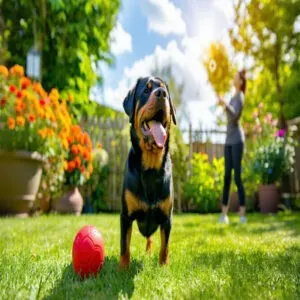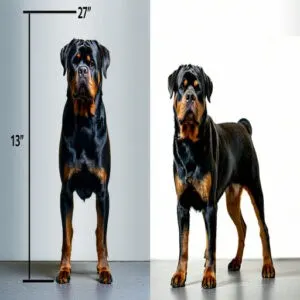This site is supported by our readers. We may earn a commission, at no cost to you, if you purchase through links.
 Mini Rottweilers are compact versions of the classic Rottweiler, standing 12 to 15 inches tall and weighing 30 to 60 pounds.
Mini Rottweilers are compact versions of the classic Rottweiler, standing 12 to 15 inches tall and weighing 30 to 60 pounds.
They share the signature black-and-tan coat, broad chest, and confident personality.
While adorable, they’re not purebred Rottweilers—miniature versions often result from mixing with smaller breeds or genetic dwarfism.
These pups are loyal, protective, and energetic, but their compact size doesn’t mean less work.
You’ll need to prioritize training, proper socialization, and regular veterinary care.
Thinking of adopting one? Make sure you research ethical breeders and don’t compromise on health.
Curious about their growth stages or care tips? Keep reading!
Table Of Contents
- Key Takeaways
- Rottweiler Origins and Characteristics
- Rottweiler Training and Temperament
- Rottweiler Health and Veterinary Care
- Grooming and Maintenance for Rottweilers
- Living With Rottweilers: Tips and Considerations
- Rottweiler Growth & Weight Chart
- Rottweiler Height Chart
- At What Age is a Rottweiler Full Grown?
- How Big Should a 6-month-old Rottweiler Be?
- How to Ensure The Health of Your Rottweile
- Frequently Asked Questions (FAQs)
- What I wish I knew before getting a Rottweiler?
- Are mini Rottweilers good dogs?
- How big do mini Rottweilers get?
- What are the weaknesses of a Rottweiler?
- What is the lifespan of miniature Rottweilers?
- Do miniature Rottweilers get along with children?
- How much daily exercise do mini Rottweilers need?
- Are miniature Rottweilers prone to barking excessively?
- What type of diet suits mini Rottweilers?
- Conclusion
Key Takeaways
- Mini Rottweilers are loyal, protective, and energetic, but they’re not purebred Rottweilers—they’re often the result of mixing with smaller breeds or genetic dwarfism.
- They need consistent training, early socialization, and regular vet care to manage their strong personalities and potential health risks.
- Ethical breeders matter—poor breeding practices can lead to genetic issues, so always research thoroughly before adopting.
- Despite their smaller size, mini Rottweilers require daily exercise, a healthy diet, and proper grooming to stay happy and well-balanced.
Rottweiler Origins and Characteristics
Although Rottweilers are popular today, their history stretches all the way back to the Roman Empire—talk about ancient roots.
Originally bred as herding dogs, they guided livestock and protected their owners, making them one of the oldest working dog breeds.
Their name comes from Rottweil, Germany, where these loyal and hardworking dogs thrived.
Known for their striking black coats with rust-colored markings, Rottweilers are large breeds with a strong, muscular build.
Males can weigh between 95-130 pounds, while females are slightly smaller at 77-110 pounds.
Behind their tough exterior, they’re intelligent, loyal, and keen to please.
Rottweiler characteristics include a natural instinct to protect, but early socialization helps channel this into calm, confident behavior.
With proper training, these ancient herding dogs become dependable companions that fit active households perfectly—miniature Rottweiler or not!
Rottweiler Training and Temperament
Rottweiler training is surprisingly straightforward thanks to their intelligence and loyal nature.
Start early with positive reinforcement—treats, praise, or a favorite toy work wonders.
Focus on canine socialization by introducing your Mini Rottweiler to new people, pets, and places to shape a calm, confident dog temperament.
Be consistent with clear rules, as this strengthens dog obedience.
Patience and reward-based training methods guarantee steady progress.
Their natural protective instincts and affectionate rottweiler temperament will shine when you combine structure with plenty of love.
Rottweiler Health and Veterinary Care
Keeping your dog healthy doesn’t have to feel like a mystery. For Rottweilers, paying attention to their specific needs is key to avoiding health complications:
- Veterinary care matters: Find a vet experienced with large breeds. Annual health screenings, vaccine schedules, and dental care appointments shouldn’t be skipped—they keep your dog’s health issues in check.
- Stay alert to cancer risks and costs: Rottweilers face higher cancer risks than many breeds. Regular checkups help catch potential problems early, saving both your pup and wallet from distress.
Stick to high-quality food that fits their dietary needs, maintain an active lifestyle, and you’ll have a happy, healthy companion!
Grooming and Maintenance for Rottweilers
How can you keep your mini Rottweiler looking sharp and feeling great?
Regular grooming is the key.
Their coat doesn’t need high-maintenance care, but weekly brushing helps with shedding control and keeps it shiny.
Use proper brushing techniques to remove loose hair and reduce mess around your home.
Nail trimming is just as important.
Trim their nails every 2-3 weeks, or when you hear that clicking sound on your floors.
Be careful not to cut too close to the quick – it’s painful for your pup!
If you’re unsure, a professional groomer or vet can help.
Don’t skip dental hygiene either.
Brushing their teeth regularly with dog toothpaste prevents bad breath and dental issues.
Like any dog grooming routine, these steps will help maintain their health and complement that perfect miniature Rottweiler size chart you’re tracking!
Keep it practical, and they’ll thrive.
Living With Rottweilers: Tips and Considerations
Living with a Rottweiler means understanding their energy, loyalty, and need for structure in your daily life.
You’ll want to provide consistent training, regular exercise, and plenty of love to keep them happy and well-behaved.
Vet’s Credibility Questioned
Choosing a vet? Don’t skip the research.
Vet ethics matter—they protect your dog from medical fraud and false diagnoses.
Some breeders cut corners, leaving you stuck with hidden rottweiler health issues.
Ask tough questions about your miniature rottweiler’s care. Accountability is key.
A reliable vet safeguards animal welfare and guarantees your mini rottweiler enjoys the healthiest life possible.
Existence of Miniature Rottweilers
Wondering if mini Rottweilers are real?
They do exist, but they’re not purebred Rottweilers.
Miniature Rottweilers are often results of dwarfism effects, small breed mixing, or naturally smaller Rottweilers.
Understanding dog breed characteristics is essential to recognize the differences between purebred and miniature Rottweilers.
While Rottweiler hybrids can resemble their larger counterparts, the miniature controversy lies in health risks and inconsistent traits.
Mini rottweiler genetics vary, so always research before adopting.
Skepticism About Breeding Practices
Breeding miniature Rottweilers often sparks doubts about ethics.
Puppy mills prioritize profit, ignoring health risks and responsible practices.
Poor breeding practices, like using runts or dwarfism, can lead to genetic issues.
Without genetic testing or breeder accountability, health concerns multiply.
For more information on miniature rottweiler care, it’s vital to understand the risks associated with unethical breeding.
Always verify that breeders prioritize welfare and conduct proper screening.
Ethical breeding isn’t optional—it’s essential for a healthy, happy mini Rottweiler.
Rottweiler Growth & Weight Chart
Tracking your Rottweiler’s growth helps you understand if they’re developing properly and staying healthy.
With a quick glance at a growth and weight chart, you’ll know what to expect as they mature.
Male Rottweiler Growth and Weight Chart
Keeping tabs on your male Rottweiler’s growth is key to keeping him healthy.
Puppy development can vary, but a guide helps track their growth stages, muscle building, and weight management.
Here’s a handy chart to compare milestones: Understanding a Rottweiler Growth chart is essential for monitoring progress.
| Weight (Pounds) | |
|---|---|
| 2 | 15-20 |
| 6 | 60-75 |
| 12 | 95-110 |
| 18 | 110-130 |
Factors like nutrition, exercise, and genetics play a big role.
Regular check-ins with your vet guarantee you’re staying on track. Remember, every dog’s journey is unique!
Female Rottweiler Growth and Weight Chart
Tracking your Rottie’s puppy development and growth patterns is key to understanding her needs.
Female Rottweilers typically have slightly smaller sizes but still need careful weight management and proper nutrition.
Use this growth chart to compare milestones: A puppy weight chart is essential for monitoring development.
| Growth Pattern | |||
|---|---|---|---|
| 2 | 15-20 | 7-9 | Rapid puppy growth |
| 4 | 35-50 | 16-23 | Steady increase |
| 6 | 50-75 | 23-34 | Slower growth |
| 12 | 75-100 | 34-45 | Almost full-grown |
Healthy mini Rottweiler weight in pounds varies but maintaining balance guarantees proper canine physiology.
Rottweiler Height Chart
Ever wondered just how tall a full-grown Rottweiler gets? It depends on whether you’re looking at a male or female.
Male Rottweilers generally stand 24 to 27 inches tall at the shoulder, while females are slightly shorter, at 22 to 25 inches.
These measurements give Rottweilers their powerful, balanced look, with height designed to match their weight proportion and sturdy build.
Understanding a rottweiler growth chart is vital for anticipating and managing the development of your pet.
Here’s a quick look:
| Gender | Height (inches) | Weight Proportion |
|---|---|---|
| Male | 24-27 | 95-130 lbs |
| Female | 22-25 | 77-110 lbs |
When it comes to mini Rottweilers, size variance exists.
A full-grown miniature Rottweiler might only reach about half the height of a standard Rottie.
However, always confirm a breeder’s credibility to guarantee the pup meets healthy breed standards.
At What Age is a Rottweiler Full Grown?
A Rottweiler’s growth is a fascinating journey, with each stage revealing more of its future size and personality.
So, when do they hit their peak?
Here’s a quick breakdown of Rottweiler maturity and development phases:
- First six months: Rapid growth; they’re almost unrecognizable from their puppy days.
- By 9-10 months: Female Rottweilers typically reach their full height.
- By 12 months: Males get close, about 95% of their full height.
- 18-24 months: Both genders fill out, gaining their full-grown weight and muscle tone.
- Maturity age: Complete physical development happens by two years.
Proper nutrition and regular vet visits are key to supporting their growth stages.
These milestones matter, even for the mini Rottweiler weight and maturity.
How Big Should a 6-month-old Rottweiler Be?
At six months, your Rottweiler should be hitting key growth stages that show it’s on track.
By this age, most pups are roughly 60-65% of their adult height and weight.
Here’s what to expect regarding puppy size:
- Weight Gain: Average weight falls between 45-50 pounds.
- Development Milestones: Height is around 18-22 inches at the shoulders.
- Breed Standards: Your pup may eat around 4 cups of kibble daily to sustain growth.
Rottweilers are all about balance—proper nutrition with protein for muscle development and glucosamine for joint strength is key.
Stick to a routine with 30-60 minutes of exercise, like walks or tug-of-war, each day.
If your puppy seems too small or heavy, check in with the vet to keep their development steady.
How to Ensure The Health of Your Rottweile
Keeping your Miniature Rottweiler healthy might feel like juggling plates, but it’s manageable with the right routine.
Regular checkups are a non-negotiable—your vet will catch health issues early and keep vaccine schedules up to date. Nutrition planning is key too, as a healthy diet reduces risks of obesity and other dog health problems. Considering pet insurance options can also provide financial protection against unexpected veterinary bills.
Markdown list to remember:
- Stick to preventative care: Vaccines, flea/tick protection, and regular dental care are essential.
- Plan their diet: Use vet-recommended food, avoiding unhealthy table scraps.
- Exercise daily: At least 45 minutes to avoid boredom and weight gain.
- Watch for rottweiler health issues: Monitor joints, heart, and eyes early.
- Stay consistent: Routine keeps health predictable and manageable.
Stay on top of care, and you’ll have a happy, healthy pup with a strong chance of avoiding common issues through regular checkups.
Frequently Asked Questions (FAQs)
What I wish I knew before getting a Rottweiler?
You’ll need patience and firm training, and plenty of socialization.
Rottweilers thrive on structure but can test boundaries.
They’re loyal, affectionate, and protective, but their size and energy demand regular exercise, consistent rules, and early social habits.
Are mini Rottweilers good dogs?
Imagine a loyal shadow by your side—mini Rottweilers are affectionate, smart, and protective.
They’re great for smaller spaces but need proper socialization, exercise, and care to thrive.
Size doesn’t shrink their big personalities!
How big do mini Rottweilers get?
Mini Rottweilers typically weigh 30 to 60 pounds and stand 12 to 15 inches tall.
Their size depends on genetics and breeding.
They’re a smaller, more manageable version of standard Rottweilers, perfect for tighter spaces.
What are the weaknesses of a Rottweiler?
Rottweilers can be stubborn as a mule, prone to hip dysplasia, and susceptible to obesity.
Without proper training, they may develop aggressive tendencies or separation anxiety.
Their protective nature requires consistent socialization to guarantee balanced behavior.
What is the lifespan of miniature Rottweilers?
You’re looking at a lifespan of around 10 to 13 years for miniature Rottweilers.
Their lifespan depends heavily on proper care, regular vet checkups, and ethical breeding practices to avoid health problems common in smaller dogs.
Do miniature Rottweilers get along with children?
Miniature Rottweilers usually get along well with kids, especially when raised together.
Their affectionate, loyal nature makes them protective companions.
But early socialization and supervision are key to managing their strong prey drive and energy levels.
How much daily exercise do mini Rottweilers need?
Aim for at least 45 minutes of daily exercise to keep your mini Rottweiler happy and healthy.
Long walks, playtime, or even mental challenges like puzzle toys help burn energy and prevent boredom.
Are miniature Rottweilers prone to barking excessively?
Around 30% of small dog breeds bark excessively, and mini Rottweilers can lean this way too.
They’re protective and vocal, so, with early training and socialization, you can teach them when it’s just not necessary.
What type of diet suits mini Rottweilers?
Feed your mini Rottweiler balanced, high-quality dry dog food, portioned for their weight and activity level.
Add lean proteins, veggies, or fruits sparingly.
Avoid overfeeding to prevent obesity—it’s easier than you think!
Conclusion
Funny how "mini" doesn’t mean less responsibility, right?
Mini Rottweilers may be small, but they demand big commitment.
Between their energetic personality, training needs, and health care, they’re not a shortcut to owning a Rottweiler.
If you’re ready to prioritize ethical breeders, proper socialization, and regular checkups, these loyal companions might be perfect for you.
Remember, research is key—everything you could want to know about Mini Rottweilers is at your fingertips with the right preparation!
- https://www.dogster.com/dog-breeds/miniature-rottweiler
- https://www.akc.org/dog-breeds/rottweiler/
- https://puppysimply.com/mini-rottweilers-everything-you-could-want-to-know/
- https://mississippirottweilers.com/miniature-rottweilers/
- https://www.hillspet.com/dog-care/healthcare/understanding-dwarfism-in-dogs













